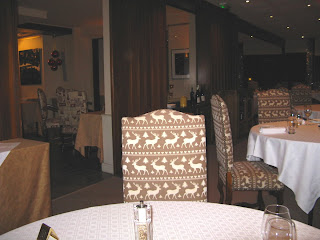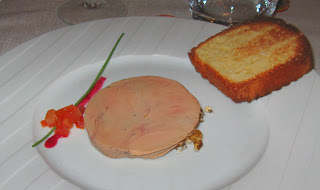The day: 30th December 2008, Dinner.
The place: 40 route de Ste-Marie-aux-Mines F-68150 RIBEAUVILLE (tel: +33 (0)3 89736414)
The venue: Restaurant Au Valet de Coeur, Hostel ‘La Pepiniere’.
The food: French
The drinks: Adequate for a starred French venue, interesting wine-menu pairings at €25, 32, 40.
For the second year in a row family events prevent us from taking a proper break over the Winter holidays. But on the road back to London we allow ourselves one treat: driving along the axis Basel-Strasbourg, just past Colmar (where we stayed last year), we turn straight towards the freezing Vosges forests and, upwards on the icy road next to the charming village of Ribeauville’, we find this hotel restaurant. As we notice not infrequently in our pilgrimages to Alsace, the restaurant seems to be one step ahead of the attached hotel in terms of comfort and overall quality. With its Michelin star, and given the excellent levels of Alsatian cuisine, we are expecting a bloody good dinner! There is a religious pilgrimage route nearby in case we want to expiate our sins later (but there is also a ‘cremant’ wine maker almost in front of the route, making for a hard choice, or an intriguing combination).
The décor is warm, in light brown and white tones, pleasant, unpretentious and varied, with several areas in the large room and the (slightly corny to be fair) ‘heart’ motif all around, even in the butter on the table. The tables are very comfortable and well-spaced. The jovial Maitre d’ adds to the sense of comfort.

Several menus are on offer, from the largest 6 course tasting menu at €85, to the 4 course ‘Menu decouverte’ at €65, to the 3 course ‘Menu saveur’ at €45. And a ‘Menu du marche’ at €33.50 features on weekday evenings and Saturday lunches. A la carte choices afford less good value, with starters at €25-35 and mains at €29-38, and with some items only available in the set menus. Had we gone a la carte, we would have tried the ‘Cour de saumon mi-cuit/mi-fume, Remoulade de Celery et Caviar d’ Aquitaine, Blinis’ (€35) as a starter. For mains, we’d been happy with our set menu which you’ll see in a minute.
We go for the Menu Decouverte (€65), and we begin with a little snack of puff pastry with poppy and sesame seeds, or topped with some kind of bechamelle sauce and lardons:

Well, not your average Gregg's offering, these are high levels of bakery.
And the bread rolls are already expecting us:
 Beautiful to look at (again the corny heart motif), excellent taste, made with strong flour as we like it, and really well made. Good start, if they can make Man and Woman happy about the bread!
Beautiful to look at (again the corny heart motif), excellent taste, made with strong flour as we like it, and really well made. Good start, if they can make Man and Woman happy about the bread!And an amouse bouche:
 A salmon mousse, St. Jacques on a mousse of green veggies, and a chestnut mousse. The cold salmon mousse regales a surprising sweetness, and is bodily, buttery, rich and compact, satisfying. Equally pleasing is the scallop, also cold, with a peppery punch that Man appreciates more than Woman, who finds it close to overpowering. As for the chestnuts, we detect potatoes in the warm, delicate and airy combination. We must say that this beginning already reveals an assured hand, with clear flavours, variety and seasoning judgement.
A salmon mousse, St. Jacques on a mousse of green veggies, and a chestnut mousse. The cold salmon mousse regales a surprising sweetness, and is bodily, buttery, rich and compact, satisfying. Equally pleasing is the scallop, also cold, with a peppery punch that Man appreciates more than Woman, who finds it close to overpowering. As for the chestnuts, we detect potatoes in the warm, delicate and airy combination. We must say that this beginning already reveals an assured hand, with clear flavours, variety and seasoning judgement.Our starters:
- Raviole de Foie Gras de Canard a la Farine de Chataigne dans un Bouillon Corse’.
- Delicate gelee de Crabe Royale, Creme de Crustaces et Harenga.


The foie gras is intense, carried by the delicate bouillon with sweet fine carrots in abundance. We appreciate the good texture of the chestnut ravioli, while the truffle is more of a decoration. This is a good dish but not altogether convincing: most of the work is really done by the great foie gras, with the rest adding little and not integrating appropriately, in our judgement.
But the Gelee...the gelee is on a different level of cuisine, the technique presenting us with a sumptuous multitude of flavours (the crab is dominant –it’s a king after all- but the lobster mousse/cream and the non-salty jelly are a very valid support) and a ravishing soft-solid consistency: this is an occasion where richness (mayonnaise is present) comes with absolute balance and lightness, leaving on the palate a satisfied sense of freshness. This is haute cuisine.
Next we have:
- Maree du jour accomodee selon l’Inspiration du Chef
- Le Baeckeoffe de Homard Gratine’ aux Poireaux

 The ‘fish according to the chef inspiration’ is an Atlantic seabass on risotto and a creamy lobster reduction. Fresh and cooked perfectly (‘crispissimo’ on the skin and moist inside) and sitting on a pleasant risotto ‘cake’ which also has a crispy outer layer, still the fish is slightly inexpressive on the palate. The rice is a tad over (Woman here unusually sterner than Man on risotto), but as Italians we’ll always say that in France… The lobster reduction is, conversely, fantastic, providing a backbone of pungent burnt flavour. A very sound dish where once again several cooking skills converge.
The ‘fish according to the chef inspiration’ is an Atlantic seabass on risotto and a creamy lobster reduction. Fresh and cooked perfectly (‘crispissimo’ on the skin and moist inside) and sitting on a pleasant risotto ‘cake’ which also has a crispy outer layer, still the fish is slightly inexpressive on the palate. The rice is a tad over (Woman here unusually sterner than Man on risotto), but as Italians we’ll always say that in France… The lobster reduction is, conversely, fantastic, providing a backbone of pungent burnt flavour. A very sound dish where once again several cooking skills converge.The beackaoffe is, as you know, a traditional Alsatian casserole, typically a rustic dish which here the chef offers instead in an ennobled and sophisticated version, with lobster instead of, for example, game. The result is totally convincing: the lobster is simply wonderful and cooked just so, held together by a texturally interesting eggy quiche-like filling with leeks adding vegetable depth. Another definite hit.
What delights. We arrive to the main mains:
- Dos de Cochon de lait Laque’, Boudin maison et Pomme de Terre Ecrasee a la Fourchette
- Pigeonneau en croute Feuilletee aux Choux Vert et Foie Gras


Oooh: In the eye-pleasing pork dish we encounter the first (and only) serious cooking flaw of the evening: it’s rather dry (remember: this is moist suckling pig, so it takes a real error to dry it up). A pity, because the rest is perfect, its flavour, its elegant ‘laque’ exterior, the exemplary reduction. And the potato and boudin ‘cake’ is to scream for, rich and velvety and decadent, a punch of strong traditional cuisine flavours classily reinterpreted.
And talking about potent flavours… the foie gras stuffing in the pigeon, which you reach after going through a pretty and texture-wise very apt ‘puff pastry’ enveloping the juicy, tender bird, is an explosion (notice the similarity of this dish with what we had here) that calls for even more screams of contentment. All accompanied by an excellent Savoy cabbage. What a movingly good dish!
And we have come to the desserts:
- Baba au vieux Rhum, Crème legere et Minestrone de Fruits Exotiques
- Carre’ Chocolat Grand Cru, Glace vanille’

 For the baba’ we have a conceptual disagreement with the Chef…We appreciate the humour of the deconstruction, serving the (excellent) rhum and (equally excellent) vanilla mousse separated: but for us the pleasure of baba’ has always been and always will remain that of the rhum enveloping your palate at the first, soft bite. So we’d say this is a deconstruction too far. This aside, there’s also a problem with the baba’ itself which, while good in flavour, is inelastic and (of course) dry and heavy. The ‘minestrone’ is, however most tasty and welcome.
For the baba’ we have a conceptual disagreement with the Chef…We appreciate the humour of the deconstruction, serving the (excellent) rhum and (equally excellent) vanilla mousse separated: but for us the pleasure of baba’ has always been and always will remain that of the rhum enveloping your palate at the first, soft bite. So we’d say this is a deconstruction too far. This aside, there’s also a problem with the baba’ itself which, while good in flavour, is inelastic and (of course) dry and heavy. The ‘minestrone’ is, however most tasty and welcome.No such problems with the other dessert: accompanied by a fine vanilla icecream, stunning chocolate and masterful technique combine to create a ravishing, marvellously beautiful cake: you go through the several layers (the chocolate ‘ganache’ covering, the chocolate mousse, some thin praline layer, the jelly/chocolate cream, the white chocolate) and...you dream.
To conclude, the petit four:

They are all very pleasant, the almond madeleine, the hazelnut praline - especially fine is the jammy density of the apricot jelly, and we also like very much the sort of chocolate brownie, which is lighter than a brownie.
(We prefer to forget this...

...just look at it! And that heart shape again, this is begining to be a little obsessive)
We said we went for the Menu Decouverte. In fact, to be precise, we went for a ‘Formule carte blanche’ (€250) which included a night in a large room for two, the Discovery menu for two, and the €25 wine paring plus water – so let’s say our dinner for two all inclusive cost €180, well deserved for the quality and quantity we experienced (the wines we tried were a Muscat d’Alsace, a Riesling 2006, a Vouvray 2006 and a Haut Medoc 1998, all nice, especially the Medoc - Chateaux Hantellan).
The service was smooth, correct, less rigid and more human than can be the case in French venues.
As you have seen we enjoyed a great dinner. Chef Christophe Cavelier is not God and does make the occasional mistake (and we even had our ‘conceptual’ problems!) but the variety of perfectly executed and conceived dishes he put in front of us, with very strong, powerful but at the same time balanced and clear flavours, always classically and elegantly presented, must make this one of the best examples of cuisine in Alsace. Not an innovative cuisine, one deeply rooted in tradition but also in a profound technique and cooking mastery, thanks to which heartiness is married to modern criteria of lightness. The menu itself was also nicely designed. And after you are satiated, the choice is yours: a religious pilgrimage, a peaceful walk in the steep woods, or a visit to the sparkling wine maker. Whatever you prefer, we recommend that you go to the Valet du Coeur!
Home
























